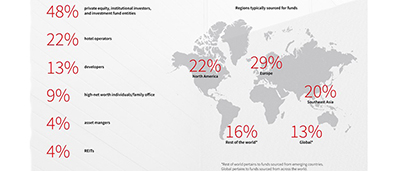
Hotel Investment Appetite Grows Despite Mixed Post-Pandemic Results

Hotel investment activity grew sharply in the first half of 2021 despite continued mixed performance results, according to separate reports on an industry hard hit by the coronavirus pandemic.
JLL, Chicago, said investment activity for the first half of 2021 reached $30 billion, inclusive of entity-level deals, an increase of 66% year-over-year and only 4% less than activity observed in the first half of 2019.
In a separate report, STR, Hendersonville, Tenn., said the anticipated pickup in hotel activity continues in fits and starts, with both U.S. hotel occupancy and average daily rates down from previous weeks through Aug. 14.
JLL said investors showed a “gust of optimism” for the industry as investors showed signs of increased activity. “With 2021 very much a year of two halves, the pace of investment activity is expected to accelerate throughout H2,” JLL said.
The report said hotel investors have their sights on Europe, North America and Southeast Asia as activity picks up. In particular, Asia Pacific hotel transactions totaled $3.7 billion in the first half of 2021, with a significant level of institutional investor funds flowing into hotel assets. With wider vaccine rollouts, North America’s market is “opportunistic,” with domestic travel continuing to increase and drive-to leisure markets experiencing a flurry of travelers. Investors eyeing European assets are encouraged by the increasing vaccination rate, with many expanding their strategies to consider less dense markets, with the diversification of assets being top of mind.
In addition, investors’ sentiment suggests that full-service hotels will endure the deepest discounts, as select-service and economy hotels were less impacted by the pandemic and still able to fill rooms. Nearly 50% of respondents expressed that the best investment opportunities to emerge over the next six months will be full-service hotels.
The report noted more than half of investors responded they will implement a more aggressive investment acquisition strategy in 2021, as they become more forward-looking, with 29% of respondents indicating interest in over $200 million worth of assets, up from 25% during the onset of the pandemic.
“Last year, navigating a zero or negative cashflow environment coupled with a high degree of uncertainty surrounding the lodging industry’s recovery profile, posed various challenges for investors underwriting hotel acquisitions,” JLL said. “This resulted in 2020 surveyed cap rates increasing an average of 120 basis points globally when compared to 2019.”
The report said with 70% of respondents anticipating their property or portfolio RevPAR to return to 2019 levels in three to four years, investors are keen on operational changes and re-evaluating strategy. An imperative function of business that has gained enormous spotlight during the pandemic is asset managers. That said, investors indicated the following to be key operational focus areas:
• Profitability improvement measures, such as service and amenity offering evaluations and labor optimization.
• Sustainable operation programming and enhanced focus on ESG.
• Guest-facing and back-of-house technology implementations.
Meanwhile, STR reported for the week of Aug. 8-14, hotel occupancy fell to 65.7 percent an 8.4 percent drop. Average daily rate, however rose by nearly 6 percent to $139.18, although revenue per available room fell by 3 percent to $91.45.
“While the metrics were down week over week, comparisons with 2019 remained consistent, which is further evidence of seasonality in the data as more schools return to class and leisure demand wanes,” STR said. “Concern around COVID-19 cases also persists.”
Among top 25 markets that STR monitors, Norfolk/Virginia Beach saw the only occupancy increase over 2019 (+0.4% to 80.0%) and the highest RevPAR increase when compared with 2019 (+24.3% to $131.07). San Francisco/San Mateo experienced the steepest decline in occupancy when compared with 2019 (-36.8% to 56.9%). Miami reported the largest ADR increase over 2019 (+24.1% to $185.00). The largest RevPAR drops were in San Francisco/San Mateo (-55.2% to $96.42) and New York City (-39.9% to $122.06).
